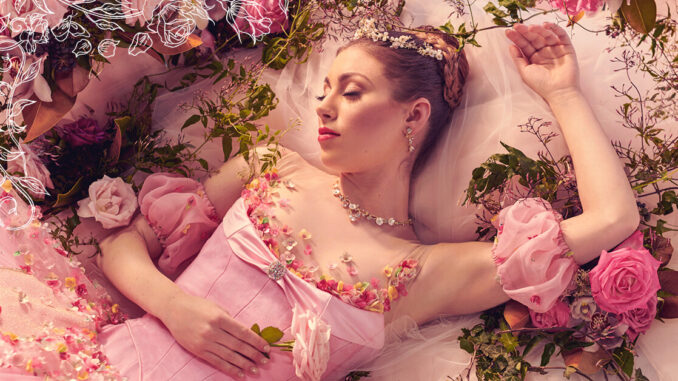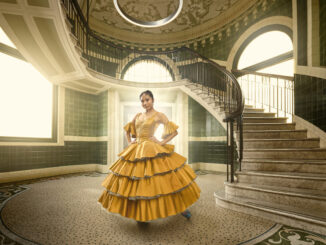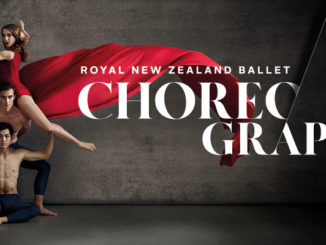
[An Awakening]
The privilege of attending a large-scale live performance of both music and dance in 2020 is not lost on me, nor, I suspect, on the majority of the audience on the opening night of The Sleeping Beauty in Wellington. Royal New Zealand Ballet, while in a better position to weather this storm than most artists in Aotearoa, has faced cancelled seasons, rescheduling, rehearsal restrictions and uncertainty in an industry where many facets of productions operate globally. Reaching opening night for a new version of The Sleeping Beauty must have enormous significance for the company, especially as it’s the first large ballet of the year and already the end of October. Despite the performance being stopped due to a technical issue a few moments into the prologue, the Wellington audience were enthusiastically supportive, and the rest of the evening ran smoothly.
Royal New Zealand Ballet created this version of The Sleeping Beauty anew, as ownership of the sumptuous and successful 2011 Greg Horsman/Gary Harris production was not retained by the company. From the opening moments of this performance, it is evident that the rich narrative and considered world-building of the previous ballet will not be matched. Whilst following the plot in its essential form, some of the more vibrant and engrossing elements of the story (banishing spindles, sleeping kingdom) are lost, leaving The Sleeping Beauty one-dimensional and in need of nuance and cohesion. Renowned American set designer Howard C. Jones has constructed the Kingdom of the Rose in a chocolate-box palette juxtaposed with austere and linear shapes, in an approach that could feel self-aware and delightfully kitsch if fully-realised and used to inform other design decisions. Unusually, the court staging sees the King, Queen and royal crib upstage on a external balcony, excluding them from fully integrating with the action. While the physical set (with its simple, stylised painting) and projected digital backdrop were individually successful, when presented together created an aesthetic dissonance that demanded an unreasonable suspension of disbelief. Similarly unusual, the projection of a rhyming plot synopsis appearing as type-written text on the curtain before each act was discordant rather than integrated.
Visually, the lurid riot of colour at the beginning of Chapter One proved the most homogenous with the marketing and set design of The Sleeping Beauty. The decision to remove The Sleeping Beauty from any particular time period offered an unrealised opportunity to create a fantastical and enchanting setting. Costumes designed by Donna Jefferis and wigs by Amy McLennan involved enormous amounts of fabric coupled with outlandish shapes and silhouettes, but lacked a cohesive or flattering aesthetic, or a definitive colour palette. Exaggerated sleeves, skirts and beehive wigs at times obscured both classical line and choreographic detail. The excessive use of white – from the King and Queen, the fairies and the corps de ballet in The Wedding – left little visual contrast for Princess Aurora and Prince Désiré during their grand pas. The exceptions were Princess Aurora’s rose tutu which remained true to the styling of The Sleeping Beauty’s marketing material, and Carabosse and her minions’ delightfully dark and dramatic costuming and fabrication.
Danced by Soloists Kate Kadow and Laurynas Véjalis, the roles of Princess Aurora and Prince Désiré are demanding in terms of technique, stamina and artistry. Although little time is afforded within the choreography for Aurora to wake or for these characters to establish chemistry, Kadow and Véjalis managed the physicality of their roles with confidence and control. Similarly, Sara Garbowski as Lilac Fairy delivered an assured and technical performance, without the depth of character and projection required to enrich the emotional landscape of the story. Royal New Zealand Ballet presents a number of young scholars, apprentices and guest dancers alongside their company dancers, meaning the professional experience of the performers is more limited than in previous years. Coupled with the large cast of child extras (who participate in a sizeable amount of choreography), the younger performers at times communicate apprehension over confidence, especially amongst the men of ensemble groups.
Company Artist Katherine Skelton and Soloist Madeleine Graham as Clarity and Curiosity are the strongest of the six fairies; their experience and confidence setting them apart in characterisation, dynamism and control on the raked Opera House stage. Bluebird and Princess Florine danced by Kihiro Kusukami and Katherine Minor provide effervescent energy and visual variety, and Principal Character Artist Loughlan Prior delivers animation and camp delight to the Master of Ceremonies role that can so easily become colourless. Unmatched for accuracy, attack, energy and powerful characterisation in The Sleeping Beauty is the endlessly versatile Kirby Selchow as the wicked Carabosse. Selchow’s abilities as an actor and a storyteller, along with striking accoutrements and entrances provide the ballet’s most memorable moments and could afford to be increased and further integrated for maximum effect.
Tackling a traditional classic such as The Sleeping Beauty in 2020 (and beyond) continues to offer challenges as audiences and the ballet world alike think harder about re-presentation of misogynist narratives. Royal New Zealand Ballet have Prince Désiré ask permission of the King and Queen before he kisses their still-sleeping daughter on the hand, however, this does not solve the issue of Princess Aurora’s autonomy and consent. Similarly, The White Cat and Puss in Boots pas de deux choreography relies heavily on the male cat touching and caressing the female cat as she repeatedly brushes him away. The choreography is humourous and traditional; the subtext a missed opportunity for the artistic team to consider how to preserve the proverbial baby but discard the bathwater.
The Sleeping Beauty has many ingredients to satisfy ballet audiences, most notably the virtuosic and beloved variations. We are fortunate indeed to enjoy an escapist Christmas ballet in the classical narrative style as we near the end of this difficult year. May it serve to remind us that the arts are as essential and nourishing as any aspect of our collective humanity.
The Sleeping Beauty tours from 29 October to 12 December, 2020.




Leave a Reply